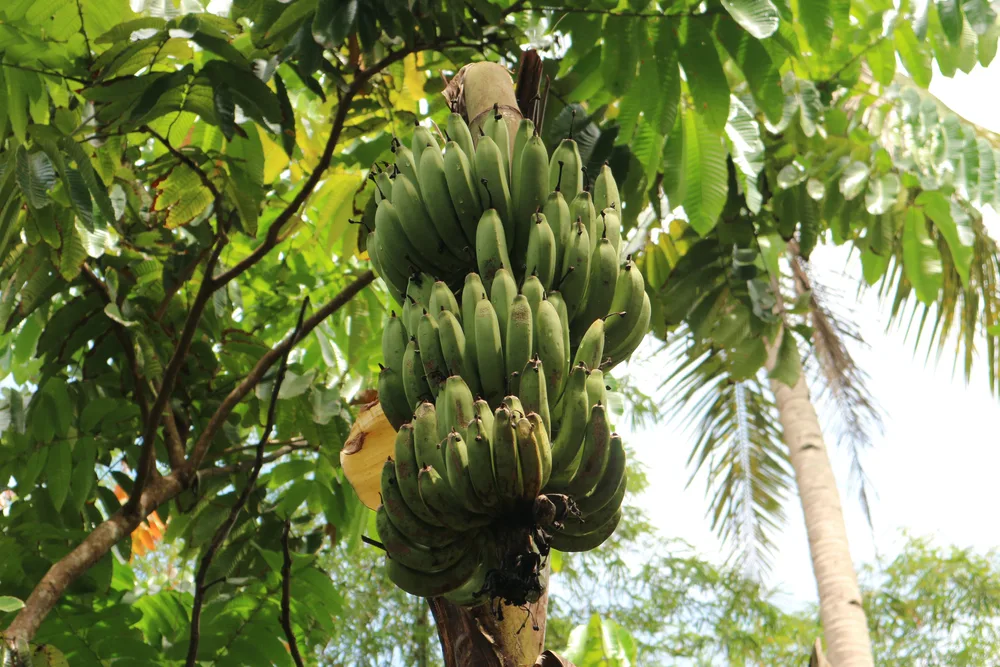
B. A. N. A. N. A. S. And no, we’re not talking about the iconic Gwen Stefani song (although we won’t judge you if it’s stuck in your head right now).
Instead, we’re going to chat about growing bananas yourself, wherever you may be.
Bananas are easy plants to grow given the right conditions (most importantly, a warmer climate). But don’t let cold climates get you down – they also do well as indoor plants. As a bonus, they will spruce up any space – indoors and out – with their gorgeous tropical leaves.
What You Didn’t Know About Bananas
Bananas are one of the most popular fruits in the United States and across the globe. But there are a few things that you might not know about this ‘a-peeling’ fruit.
The banana fruit is technically a berry, and the plant is actually a perennial herb, not a tree. This classification is due to the plant’s flesh-like trunk (rather than woody) with leaves wrapped around it. These leaves start growing underground, pushing older leaves outward as they grow.
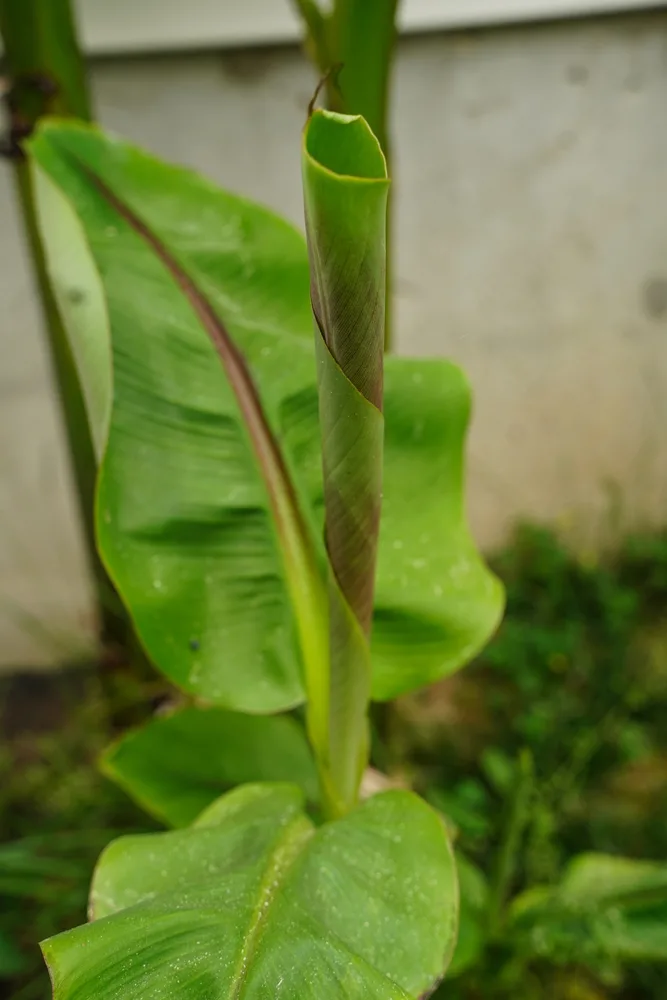
A banana plant’s root system is known as a corm or rhizome. There are some other interesting names referring to the fruit: a bunch or cluster is known as a hand and each banana is a finger. There are several varieties of bananas, the most common being Cavendish and Lady Finger.
Bananas grow best in warmer tropical climates with plenty of sun and humidity, usually in USDA zones 9 through 11. With that said, the plant does not enjoy extremes and grows best in consistent conditions with temperatures ranging between 75F and 95F.
Some banana varieties have been bred to survive colder temperatures. These hardy bananas may survive in zones as low as 5. However, keep in mind that the plant won’t develop fruit in temperatures below around 60F.
Now that we know a little more about them, you can decide where your plant will do best – inside, for your personal piece of the tropics, or outside, where they can grow beautifully tall.
Let’s go bananas and start planting.
How to Grow Bananas in Your Garden
Planting
Banana plants love the sun and heat but are prone to sunscald. It is best to plant your chosen variety, most commonly Cavendish, partially in the shade. It flourishes in slightly acidic to neutral soil that is well-draining and rich in nutrients.
Banana plants can grow to 20 feet tall depending on the variety. Cavendish types can be as tall as 18 feet, so it’s best to protect them from strong winds. Plant your bananas close to and amongst other shallow-rooted plants – known as block planting – to protect the plant. With this in mind, you should still practice good spacing to optimize fruiting and overall plant health. Each plant should be around four feet apart.
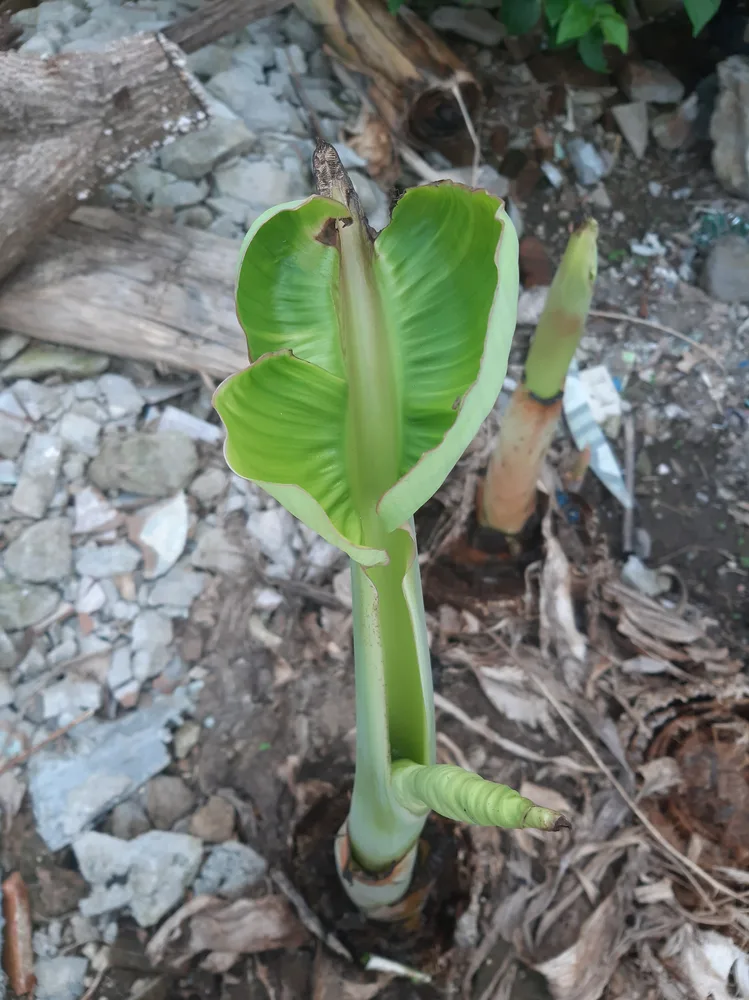
Start by enriching the soil with compost. Dig a wide enough hole for your plant, about knee-deep. Once planted, create a mound of soil around the base to facilitate drainage.
Care
Caring for your banana plant is relatively easy, but as always, it does require some TLC.
Bananas are thirsty plants, so be sure to water your plants frequently. Sprinklers are a great option because they also increase the humidity around your plants. Never overwater your banana plant and ensure there is sufficient drainage to avoid root rot. Mulching around your plant will also aid in keeping the soil moist.
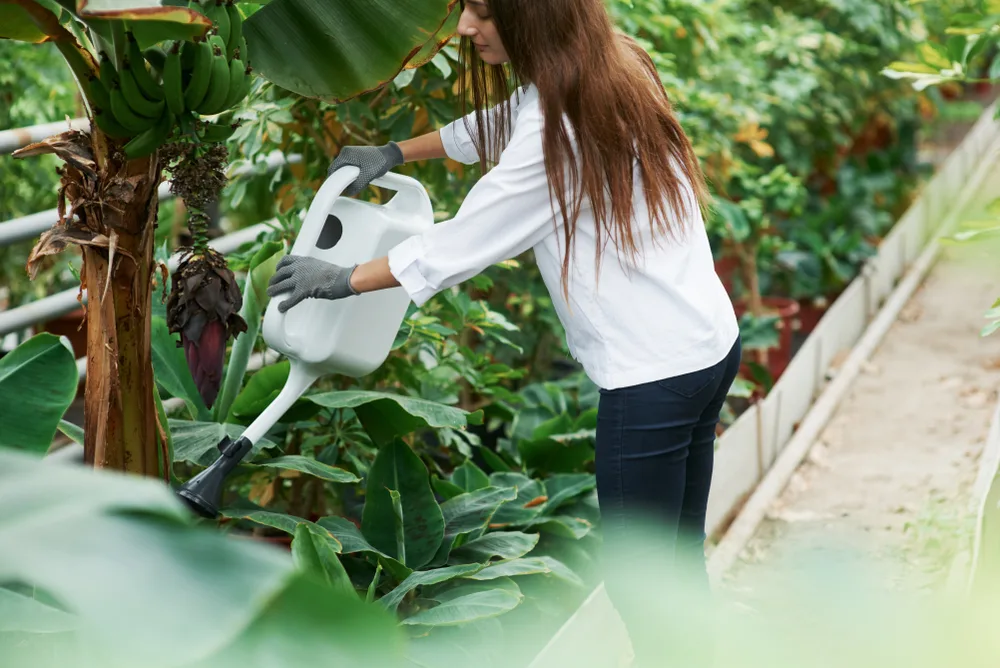
They’re also relatively hungry plants. Be sure to fertilize well throughout the season using a potassium-rich fertilizer and good organic compost.
Dramatically pruning leaves is not a major concern for bananas. To keep the plant healthy, it’s best to just remove any dead and discolored leaves. Suckers or pups that grow from the corm, on the other hand, can sap some fruiting energy from the plant. Remove any unwanted pups with clean, sharp pruning shears to ensure all the plant’s energy is directed at growing fruit.
Grow a whole tropical paradise in your backyard with 19 Tropical Plants You Didn’t Know You Could Grow.
Pests
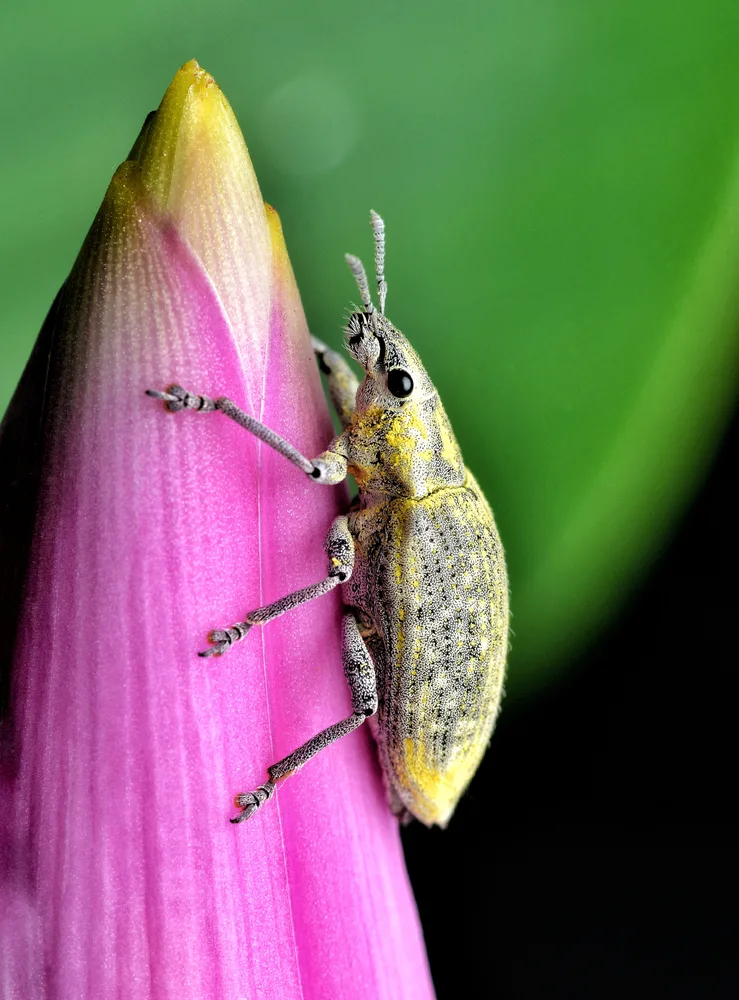
Aphids (they just love everything don’t they?), mites, and snails are a few pests that enjoy banana plants. Aphids and mites can be found on the underside of leaves – remove using a water spray bottle filled with soapy water. Or try releasing ladybugs on your banana plant.
For snails, you can trap them using a beer trap, or simply pluck them off your plants. They generally appear at night, easiest to spot with a torch in hand. Here are some more ways to deal with snails.
You may also encounter banana weevils that love banana roots and stems. Unfortunately, if you find weevils hiding in your banana stem, the best way to get rid of them is to remove the stem altogether.
How to Grow Bananas Indoors
Planting
Growing bananas indoors is as easy as growing them in your garden. Even inside, with enough light and pot space, they’ll grow to their expected height. Opt for the Dwarf Cavendish variety if height is a concern. This type has a fitting name, growing half as tall as others of this variety.
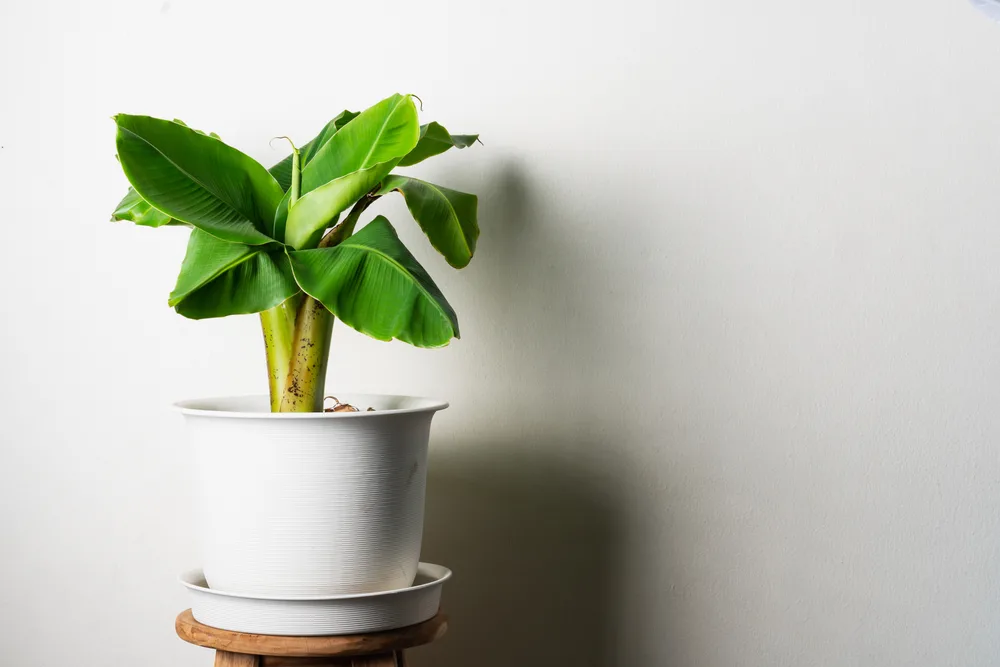
Your banana plant still requires rich soil with high levels of potassium and slightly acidic to neutral pH levels when inside. Don’t forget to fertilize using an organic fertilizer.
Bananas can be planted in any type of pot, as long as it provides enough space. They should be large enough to contain its root system and allow for decent drainage. Be prepared to repot your plant if it grows too large.
Care
Water
Watering your bananas is extremely important. The soil should remain moist but never drenched. Root rot may still occur in pots if overwatered.
Water deeply, allowing all excess water to drain completely. Remove any extra water from the pot’s saucer too. Your bananas will thrive if you water consistently.
Light and Temperature Control
Bananas plants require plenty of light to thrive and produce healthy delicious fruits. Ensure your plant is getting between 8 and 12 hours of sunlight throughout the day, keeping in mind that the quality of light outdoors is far stronger than through a window indoors.
You can also move your plant outside for a few hours to soak up the rays and enjoy the temperatures in summer, or use an appropriate indoor grow light.
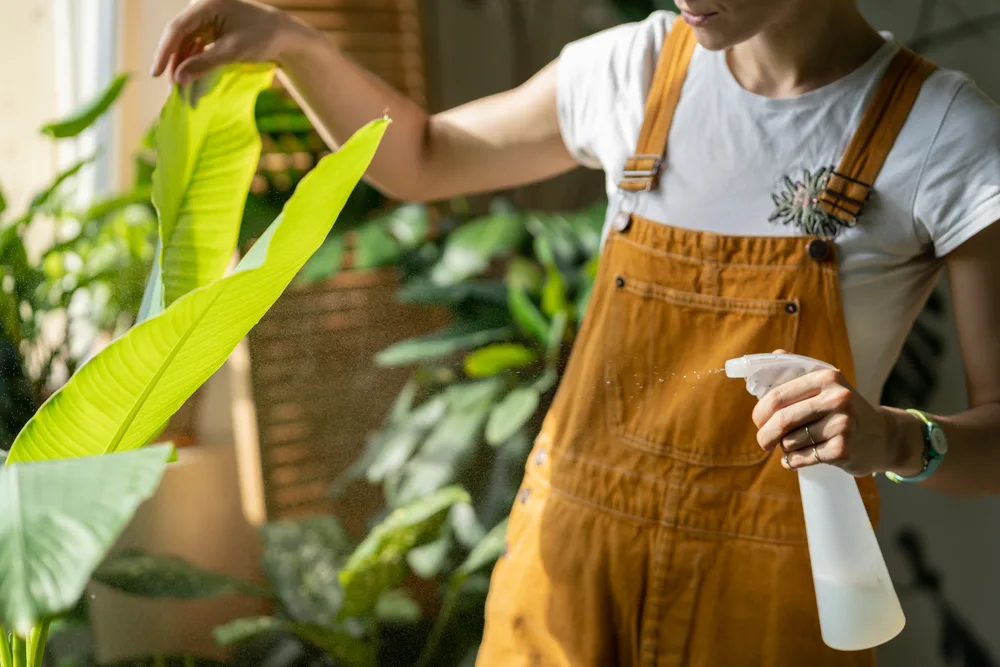
Humidity is also important for this tropical plant. Luckily, there are ways to increase the humidity in your home. For smaller rooms, a humidifier may work, or you could mist your plants with a spray bottle several times a day.
Pruning
Pruning is far more important for potted bananas than those grown outside. The suckers that grow from the root system will cause overcrowding in the pot. Remove older and damaged leaves and suckers with your sheers.
Harvesting and Storage
It takes between six and nine months for bananas to mature, flower, and begin fruiting. While maturing and fruiting, the plant becomes heavy. Place supports to prevent stems from breaking and snapping.
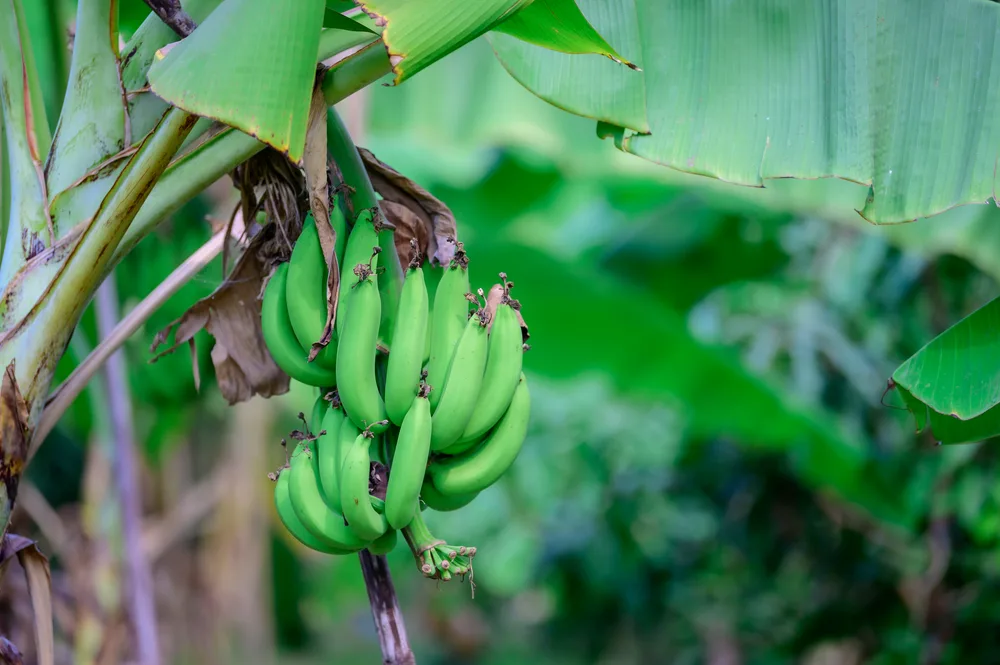
Your banana hands will be ready to harvest once they’re plump and rounded. The flowers will also be slightly dry and small at the ends of the bananas.
It’s best to harvest your bananas when they’re still green and let them ripen off the stem. They’ll continue to ripen and become more flavorful in shaded areas. Harvest the entire hand at one time by cutting it off at the stem.
Once all the fruit has been removed from the plant, it will die back. If protected from cold, the rhizome will overwinter and grow again in spring. Alternatively, you can replant a pruned sucker with its root system. For indoor bananas, it’s best to remove the plant and repot.
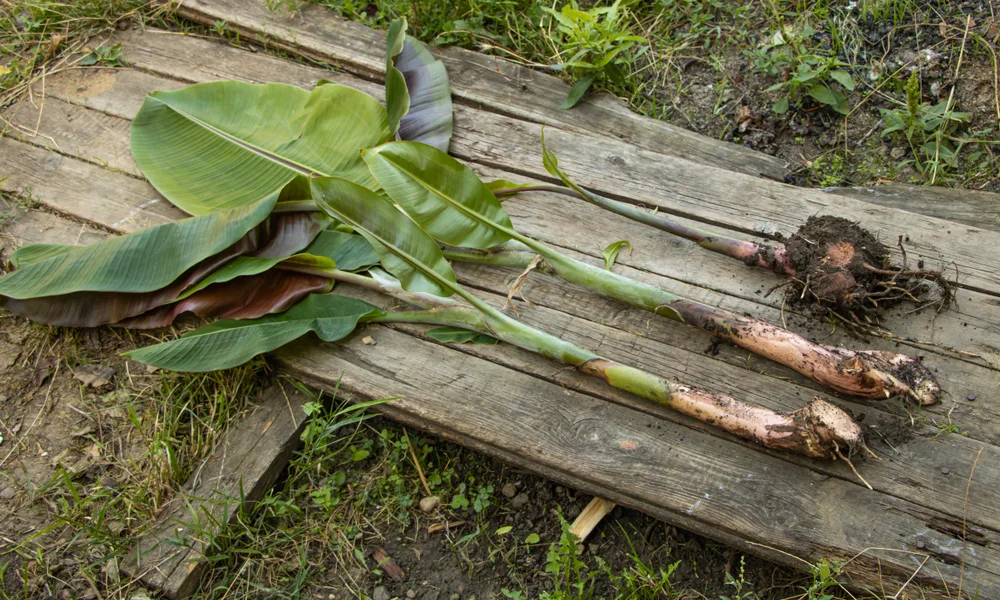
Once harvested, store your bananas in a shady area. You can keep them in the fridge, but don’t wrap them in plastic. Cooler environments are a must to avoid rotting.
The best way to keep your bananas fresher for longer is to freeze them. Peel them and slice them, then pop them in a freezer bag. They will thaw normally once removed from the freezer, or as a bonus, you’ll have frozen banana pieces ideal for your morning smoothie.
Bananas may seem like a daunting tropical plant to grow yourself. However, they are relatively easy plants given the right conditions, growing and thriving either in your garden or in your home.
Want to grow more fruit indoors? 12 Fruit Trees You Can Grow Indoors For An Edible Yield

Get the famous Rural Sprout newsletter delivered to your inbox.
Including Sunday ramblings from our editor, Tracey, as well as “What’s Up Wednesday” our roundup of what’s in season and new article updates and alerts.

